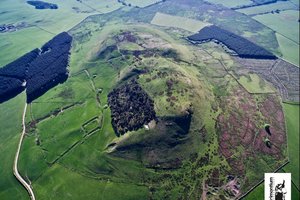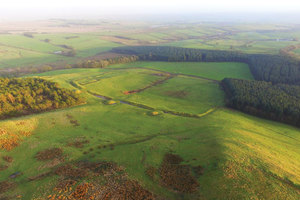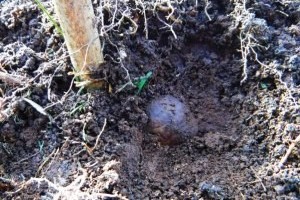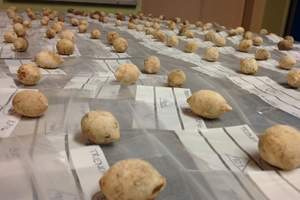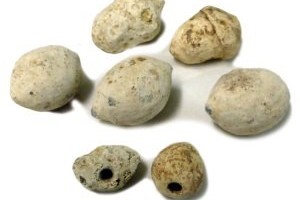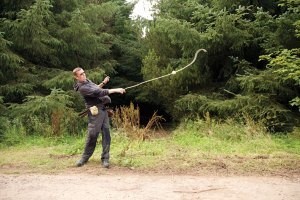Projectiles, Ballistae, and Bersnwark
Birrenswork Hill
It rises nearly 1,000 feet from the gentle surrounding countryside and is one of the most prominent landmarks in the Solway Basin. On a clear day, the panoramic view from the top is breathtaking, while on a cloudy day the hill looks ominous. But it's not just the intimidating view of Birrenswork that has intrigued scholars for the past 300 years.
At the top of the hill lie the fortress walls of a 17-acre hillfort, which is held in the grip of two Roman camps. Both of these camps have unusual outlines. The northern camp has an unusually elongated shape, while the southern one has a more traditional shape but was equipped with three wide gates facing uphill. All these gates are protected by a large mound, known as the "Three Brothers". This arrangement of Roman camps is unique to Britain and attempts to understand its significance have caused considerable controversy for over half a century.
Roman camp - training or siege?
For nearly two centuries, these camps have been identified as siege camps, but a new theory emerged in the 1960s. It suggested that the camps were training grounds and could reveal information about the training regimen of the Roman army. Further examples of this theory include the camps at Catterick in Yorkshire and the camps around the Scottish hillfort of Lothian Votadini. The former is considered an early Roman fort with adjoining temporary camps, and the latter apparently a campaign camp.
It's not hard to guess how this theory came about. Many archaeologists in the 1950s and 1960s were former military personnel, familiar with antiquity, and closely linked to the training activities of the British army.
The first to propose the idea of a training camp was Kenneth Steer, then secretary of the Royal Commission on Ancient and Historical Monuments of Scotland, and a true "Monument Man" with experience in military intelligence. Unlike many archaeological musings influenced by the spirit of the times, the idea of training camps under Birrenswork proved resilient, entering academic literature as fact.
Previous research
Two major excavations have been carried out at this location in the past. The earliest excavations were conducted in 1898 on behalf of the Society of Antiquaries of Scotland, which included a survey of the camps and excavation of the hill. Numerous lead projectiles, stone ballista shots and parts of Roman equipment subjected to corrosion were found, suggesting intense conflict.
The second major study was conducted in the 1960s under the leadership of the highly respected archaeologist George Jobey. In the publication of his work in 1978, Jobey firmly sided with the idea of training camps. He acknowledged that the stone rampart of the fortress at the top of the hill was already in a state of ruin by the time it was bombarded with projectiles and concluded that no self-respecting Roman commander would besiege an undefended hilltop, although ancient literature suggests otherwise.
Several lead targets were found in the gates of the hillfort, the purpose of which, according to Jobey, was to check the shooting range.
Over the years, the number of arguments in favor of both the idea of training camps and active military camps has increased. As often happens, many ideas have turned out to be contradictory. For example, the unique appearance of the Roman camps is explained either by clumsy construction or by the requirements of battle conditions.
The absence of a wall isolating the hilltop has also been frequently mentioned, but its significance is dulled by the fact that such blocking walls have been found in less than 20% of known Roman siege sites. There is also the city itself, and some argue that the "gentle" slope leading to its gates eliminated the need for a large number of defenders. And yet it's not a small settlement: the hillfort is the largest known in Dumfriesshire, while the slope leading to it is comparable to many European landmarks.
Against the background of such contradictions, the Trimontium Trust [a special project of the Scottish Museum for the study of Roman history in Britain (translator's note)], based in Scotland, decided to analyze all the evidence and obtain current data. The data will be collected using modern methods that originate in the archeology of battles, reconstruction, and forensics. After discussing the idea of the project with the landowner Sir John Buchanan-Jardine and in cooperation with Dumfriesshire archaeological council member Andy Nicholson, an innovative project was developed. It was based on a systematic survey of excavation sites using a metal detector to identify lead projectiles and determine their spread.
Unlike many battlefields, which lie beneath faceless plowed lands, the site lies right on top of the fragile and crumbling hillfort, which will hinder the mass extraction of artifacts from any subsequent archaeological research. Therefore, the idea was to investigate without subsequent extraction of finds. For these purposes, the latest metal detection technology is used to determine the nature of metallic targets without extracting finds, and then to conduct trial excavations to confirm the spread of the projectile. This was made possible by using a high-quality reference detector, which was calibrated with signals received from the bullet slings of the Birrenswork excavations of 1898, conducted by the museum in Dumfries.
Of course, the use of such a method of metal detection is not new: it has been in practice since at least the 1980s when Scott and Fox's pioneering work showed what really happened to General Custer and the soldiers of the 7th Cavalry Regiment at Little Bighorn. Indeed, metal detection is a primary method of surveying to identify and determine the extent of battles that took place after the advent of gunpowder; Roman lead sling bullets provided an ideal opportunity to investigate the true extent of metal projectile scatter.
The Burnswark Project was also developed to study the structure and origin of the Roman camp and how it relates to the protection of the hillfort (or its lack) and the broader landscape. It should also investigate the ballistic properties of Roman projectiles and their structure.
Given the great interest in the site and in line with the educational objectives of the Trimontium Trust, a successful application was made in 2014 to participate in the Heritage Lottery for a volunteer-supported community-based archaeology project that includes an excavation phase followed by a tourist exhibition. Work began in 2015, and two sites were carefully selected by pre-systematic metal detection. We were lucky here to be able to cooperate with Derek McLennan and Sharon McKee of Beyond the Beep, who lead a group of expert searchers based in Ayrshire.
The morphology of the Roman camp
Despite classic references about the destruction of numerous oppida in southern England, no serious sieges have been observed in Britain. This absence is notable considering that there are many examples of siege actions in mainland Europe and the Middle East. This anomaly made us doubt whether the Roman camps in Burnswark were truly siege camps in the full sense of the word, or rather assault camps to the south and blockade camps to the north.
This explains a number of unusual features. First, the southern camp was located on the slope of the hill, only 130-150 m away from the two southern gates of the hillfort. Three gates face the direction of the mountain (unlike the single narrow gates on other sides), suggesting the intention to provide quick movement of a large number of troops from the camp to the entrances to the hillfort.
On the other side of the hill, the smaller elongated northern camp was located at a greater distance from the hillfort, the more protected, northern edge of Burnswark. The position and irregular shape of the camp were designed to prevent any attempts to sneak past the hillfort's only northern gate. In both camps, the ditches facing the hill are significantly larger than on other sides, which again suggests a response to a real threat.
Roman projectiles
Burnswark has yielded more diverse Roman projectiles than anywhere else in Britain. One must travel to the Middle East to find another site rich in a similar number of finds. Before the start of the current project, 130 lead sling-bullets, nine iron arrowheads, and 11 carved sandstone ballista balls had been identified. The lead sling-bullets were found to belong to two main types. Stephen Greep, who published the first review of Roman sling-bullets from Britain, characterized them as Type I, essentially lemon-shaped, and Type II, which resembles an acorn. The more rare acorn-shaped projectiles were found almost exclusively within a 50-mile radius around Burnswark Hill. Weighing an average of 50g, these beautifully cast projectiles were primarily found at the eastern and central southern gates of the hillfort, as well as in the southern camp. It's hard to estimate whether these clusters were caused by targets at the former gates of the hillfort, as Jobey believed, since these were virtually the only parts of the hillfort that he excavated. We hoped that our study of the distribution of projectiles would give a more accurate picture of their dispersal.
Before moving to the field, a detailed examination of Burnswark projectiles held in the National Museum of Scotland and the Dumfries Museum was undertaken. This gave a number of ideas about the events that unfolded on top of the hill. The size and shape of the carved stone ballista balls were particularly interesting. These red sandstone projectiles, weighing on average 600g, were almost all grapefruit-shaped and had at least one slightly flattened side. Alan Wilkins, an expert on Roman artillery, confirmed that the flat area would lie in the 'slot' of the torsion catapult's slider and help stabilize the ball before shooting. He also noted that the stone shots were in the light class of siege engines compared to some of their larger brethren lost in Judaea. This suggests that they were chosen not for their wall-busting qualities but for their anti-infantry qualities.
During Jobey's investigation on the rampart of the southern hillfort, a number of tricolor iron arrowheads were found, despite the heavy corrosion caused by very acidic soils. They were widely distributed throughout the 1st and 2nd centuries and often associated with Arab or Syrian archers serving in the Roman army.
Some Type I lemon-shaped projectiles were significantly smaller than others, many of them weighing less than 20g. We identified a third, previously unrecognized, subgroup of throwing weapons. Even more interesting was the fact that this small shot contained one round hole, about 5mm in diameter and about 5mm deep. What could it be for? Was this hole for attaching to a device, introducing poison, or even a very symmetrical air bubble? Field trials of the sling soon proposed another, no less remarkable, explanation for these cavities.
Sling Experiments
We undertook a ballistic assessment of lead sling-bullets previously found on site to assess the effectiveness of these munitions. Several precise copies were cast from lead and high-density clay, and one of our volunteers, an experienced slinger, learned to weave slings from various materials. We found that the larger 50-gram projectiles could be thrown no less than 200 meters, depending on whether a straight (more accurate) or longer (or longer) type of sling was used. Other experimenters in this field note that a 50-gram Roman projectile, driven by a sling, has just a little less kinetic energy than a shot from a 44-caliber Magnum!
In our shooting on rugby fields, several results quickly became obvious. Despite the Day-Glo bullets being painted orange, detecting spent lead projectiles in most cases was impossible as they buried themselves in the grass, confirming that the Romans would not have been able to recover them after action. When our slinger was in rapid-fire mode, he tended to drop about 5-10% of the sling's projectiles while loading. This phenomenon of "dropped" ammunition has been noted by archaeologists on battlefields across a range of time periods and theaters of war. It is almost certainly a product of stress, and it means that the scattering of projectiles in the southern camp at Burnswark could show where the slingers were positioned at the start of the action. Two unusual facts about small projectiles with holes (currently called type III) also manifested. Firstly, they could be successfully grouped into small groups of three or four to form a circle. This was independently confirmed by T. Richardson in his work on Roman projectiles at the Royal Armory. Even more intriguing is the fact that the mysterious holes impart an aerophonic quality: during flight, this lead shot whistled, or, more accurately, emitted a mechanical buzzing sound, eerily reminiscent of an agitated wasp. As surprising as it may be, the simplest explanation for this design modification is that it represents an early form of psychological warfare. In other words, the Roman attackers liked to create terror among the defenders when they heard projectiles hitting their comrades.
Projectile distribution
In Burnswark, a team of detectorists spent seven days surveying the site. Identified metallic targets were profiled and characterized by a master detectorist to ensure the accuracy of results. GPS positions were recorded and mapped by Andy Nicholson. More than 2000 new targets were revealed, about 700 of which had the characteristics of lead projectiles. We positioned our two 10x2 m trenches so as to include the maximum number of potential sling-bullets in the excavated zone to test the accuracy of our metal detector survey. The trenches were dug over three weeks by our volunteers, overseen by professional archaeologists David Devereux, Diana and Claire from Rathmell. Trench 1, located within the fort, was full of the projectiles described above. Trench 2 was deliberately located on the southern rampart of the fort, to the west of the west gate. This not only confirmed the presence of lead projectiles but also facilitated the finding of two beautifully carved ballista bolts and a roughly carved stone sling projectile.
As some previous commentators had speculated that no real action could have been undertaken without the presence of legionary troops, the discovery of one of the stamped ballistic bolts with iron tips was also a source of some satisfaction. Our excavations confirmed George Jobey's conclusion that the bombardment occurred after the destruction of the main stone rampart that circled the hilltop. In areas where the rampart and munitions overlapped in trajectory, projectiles lay either on top or inside the crater. Overall, the match rate of identified but unexcavated projectiles with the actual projectiles found in our excavated trenches was 94%. This provides a significant margin of confidence in our forecast of projectile distribution.
Storming Burnswark Hill
So can Burnswark Hill be considered a training camp? The evidence against this theory is becoming increasingly compelling. A detailed study of the two Roman camps suggests that their location represents a real tactical response to the terrain and level of threat. Their form and position were consistent with their presumed role, enabling a blockade, covering a frontal assault, and preventing a reverse blockade. The type of ammunition also seems significant. Instead of firing projectiles made of stone or clay, which might be expected from "disposable" training ammunition, the use of carefully cast lead projectiles supports military undertones. The presence of aerophonic projectiles also suggests a desire to break the nerves of the defenders, and their variety indicates the presence of a mixed force of auxiliaries and legionnaires. As Freeman and Pollard noted, "the distribution of finds vividly demonstrates the nature of the military action". In this context, the project confirmed that there was a powerful artillery barrage at Burnswark. This was not confined to the gates, but extended along half a kilometer of the rampart. The simplest explanation for this distribution is that the defenders on the hilltop were suppressed by a hail of sling projectiles with a precise range of 120 meters and stopping power comparable to a modern handgun, as well as ballista balls, ballista bolts, and arrows. Presumably, this covered an attacking force pouring out of three massive gates and storming the hilltop. Such a combination of artillery and regular infantry would likely have been extraordinarily effective.
What now?
We believe that the results of the Burnswark project allow us to move beyond the theory. Perhaps now, we will turn our attention to when and why these catastrophic events occurred. Could the Roman action have been a show of force in response to an attack on the newly built Hadrian's Wall in the mid to late 120s? Or was it a bloody engagement of troops in the early stages of Antoninus' assault on Caledonia in the late 130s? Sparse dating evidence makes both scenarios possible. Bearing these thoughts in mind, we plan further research in the camps and the fort to unravel a few more mysteries of this site.
Similar topics
Literature
Lucia Marchini Bullets, ballistas, and Burnswark / Lucia Marchini // Current Archaeology.- № 316.-2016
